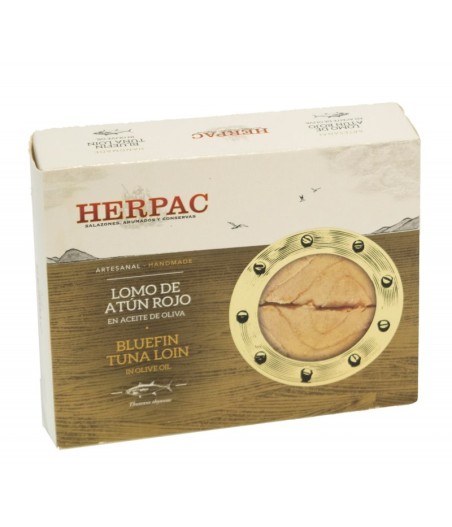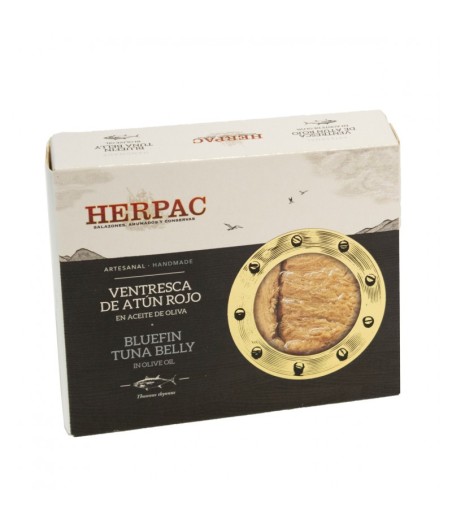Herpac, cans from the south of Spain
We are going to talk about Conservas Herpac and how the Pacheco brothers, Francisco and Diego, opened their small fishmonger to expand internationally. Today, they have huge facilities and a presence in 10 countries.
Discover its history, its products, its curiosities and a recipe.
1. Conservas Herpac, 35 years of history
35 years ago Conservas Herpac was born. Francisco and Diego Pacheco, after many years working in their fish shop, decided to move forward in their professional career and start marketing salted tuna, made by hand.
The quality of their products catapulted them to success, and they have the PGI distinction "Mojama de Barbate" nowadays. Even so, they continue to maintain the essence of a traditional family business. In fact, in its factory, the ancient and traditional art of tuna manual cutting is still taught live, a product for which they are known all over the world.
Conservas Herpac is synonymous with maximum quality, recognized with a long list of national and international awards.
Our products Herpac
2. Preparation of Herpac Conservas
At Conservas Herpac they work in a very demanding quality control that guarantees their products to comply with all regulations before being marketed.
The preparation, microbiological controls and the cleaning and disinfection processes, as well as a documentation and registration system. They have obtained the Protected Geographical Indication for the "Mojama de Barbate" in their bluefin and yellowfin tuna products, both in their extra category and in the first category.
Conservas Herpac is committed to the consumer and the environment because they only work with fish caught legally, even reaching the “Dolphin Safe” certificate. It is a leading food company that the customer can trust. It also has a privileged geographical location, since Barbate is the gateway for bluefin tuna to the Mediterranean sea.
The process of making Herpac Conservas is carried out by professional artisans who respect tradition to the maximum.
Once the best products are selected, the elaboration will continue with the tuna roasting. This is the artisan cutting, and from there the preparation of the preserves using traditional methods. We already anticipate that it is not necessary to add many ingredients. The simplicity enhances the flavor.
The pieces obtained will be placed in brine for cooking. Later, the thorns and remains of skin or inedible parts are removed, they are packaged and finally the olive oil is added.
Once the packaging is complete, the cans will undergo a sterilization process that will make them suitable for human consumption during the next 5 years.
3. IGP Mojama de Barbate
The mojama is obtained from the loins of Thunnus albacares tuna, commonly known as Yellowfin tuna, Thunnus thynnus or bluefin tuna. Specifically, the parts used are the upper and lower loins, which will be “cured” by means of a salting and air-drying process.
La Mojama de Barbate can be classified as extra or first class. The Extra class will be the one that comes from the inner part of the loins, closer to the spine and least fat. The first class will be extracted from the outer areas, more fat.
The geographical area of the PGI “Mojama de Barbate” includes the towns of Barbate, Zahara de los Atunes and Vejer (Cádiz). All the processes necessary for its production, including packaging, must be carried out in these locations.
Likewise, the labeling must appear next to the logo of the European Union.
4. Bluefin tuna back in olive oil Herpac
One of the juiciest parts of tuna is its loin. It is one of the leanest and cleanest parts, and the most used for its size and cleanliness.
Bluefin tuna back in olive oil Herpac has a characteristic flavor that will surprise the most demanding palates with its juicy texture, and its mixture with olive oil and sea salt. In addition, it is healthy due to its low fat content.
5. Bluefin tuna "Ventresca" in olive oil Herpac
If we talk about Tuna belly in olive oil Herpac canned food, famous for its popularity. The Bluefin tuna "Ventresca" in olive oil Herpac is juicy, with an irresistible texture that is slightly more fat than the loins and with a very recognizable flavor.
It is a source of protein and fatty acids, such as omega 3 or 6.
6. Recipes with Herpac Conservas
As a final touch, we leave a quick and easy recipe as a suggestion to enjoy Herpac Cans.
Now that we are almost at the end of the summer season, what is better than a roasted pepper salad with a touch of tuna belly in olive oil Herpac. We leave you the ingredients and their preparation.
- 1 can of Bluefin tuna "Ventresca" in olive oil
- 2 large red peppers
- 1/2 onion
- 6 anchovies
- Vinegar
- Oil
- Salt
1. Brush the red peppers with olive oil and put them in the oven at 180 degrees. After 45 minutes, remove them and put them in a bowl that you must cover with plastic wrap.
2. Cut the onion and marinate it with a little vinegar.
3. Once the peppers have cooled, peel and cut into strips.
4. And voila! Now you can plate the pepper strips as a base, the onion and finally, the belly.
5.- Dress to taste. Enjoy!
 4,9 / 5
4,9 / 5 







